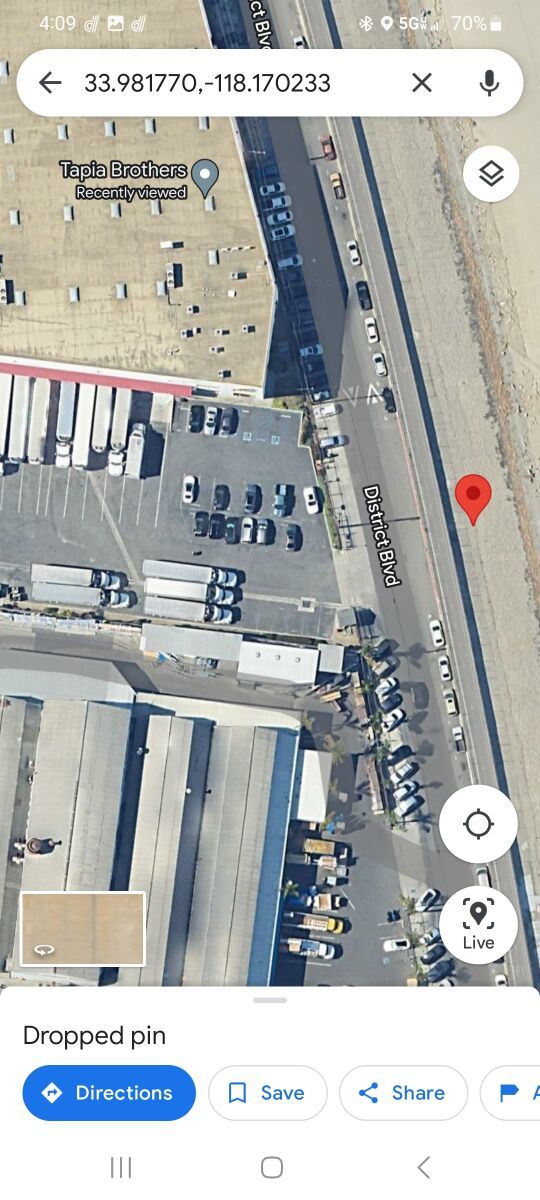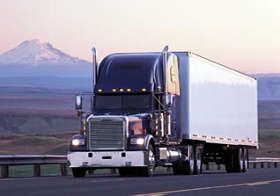Backing With Limited Forward Room
Topic 33104 | Page 1
This is a pretty common issue to run into. It's in between a 90 and a 45. By not quite pulling so far forward on the right, and extending further once you turn back left, you'll be able to arc the trailer more slowly without taking so much counter room. Your tractor will be more at like a 30 or 25 degree angle to the trailer when you start the back.
A good exercise, in a large empty area, pull along a row of spots to a stop, leave a very slight angle between your tractor and trailer. Back straight up and literally watch your trailer arc and then jack knife. As it starts to turn, simply follow it in.
The object of the exercise is not to land it in a specific spot, rather to get a feel for backing with little or no counter movements as well as how long it takes the trailer to arc.
The bit of caution I'd say is that the shallower your angle to a hole, the more outswing you'll have on the blind side, especially with the tandems close up.
Below is a picture of a customer I just did. It involves a back off the street into their yard, and a back into the spot.
Neither have enough room to swing the nose for a conventional 90 or 45. The spot has limited room, about 6 inches each side, so a few pull-ups were necessary as well as plenty of goals. Setup is basically starting a shallow angle with the back of the trailer about 20 feet past the spot intended to land in

Tandems:
Tandem Axles
A set of axles spaced close together, legally defined as more than 40 and less than 96 inches apart by the USDOT. Drivers tend to refer to the tandem axles on their trailer as just "tandems". You might hear a driver say, "I'm 400 pounds overweight on my tandems", referring to his trailer tandems, not his tractor tandems. Tractor tandems are generally just referred to as "drives" which is short for "drive axles".
Tandem:
Tandem Axles
A set of axles spaced close together, legally defined as more than 40 and less than 96 inches apart by the USDOT. Drivers tend to refer to the tandem axles on their trailer as just "tandems". You might hear a driver say, "I'm 400 pounds overweight on my tandems", referring to his trailer tandems, not his tractor tandems. Tractor tandems are generally just referred to as "drives" which is short for "drive axles".
This video has helped me a lot

Thanks Davy for the respond and actually giving a picture to go with it .
Yes now I kind of understand now . So pretty much when I go to do my hard left I need to go 5-10 more feet than my usual setup to accommodate for the space on the right when I go chase my trailer ?
I really appreciate the help .
Thanks Davy for the respond and actually giving a picture to go with it .
Yes now I kind of understand now . So pretty much when I go to do my hard left I need to go 5-10 more feet than my usual setup to accommodate for the space on the right when I go chase my trailer ?
I really appreciate the help .
I hated hearing this but it's true...every back is different. Unfortunately there's no specific formula but in general, the idea is to get a good setup first and foremost. Everyone is a bit different and I certainly have been told I'm off the wall when it comes to backing.
In this type of scenario, I stopped doing as much of a setup for a 45, which is that z turn and concentrated more on both my clearance for stuff of the blind side as well as what is going to allow the trailer to arc into the hole. But effectively yes, at least 5 to 10 feet further.
The shallower the setup angle, the more distance you need as it is progressive (the arc).
If you're trying something new, be extra cautious and don't get married to a bad setup. It takes time and repetition to develop a feel for it. I routinely park and do exercises that challenge me.
When I trained, the set up was the standard of: turn hard right until the 12 o’clock point. Then hard left to the 9 o’clock point. And in ideal situations this works well.
But as you have pointed out, we don’t always have the luxury of ideal conditions. In tight places we might have to modify the setup by doing this: Turn hard right, but only go to the 10 o’clock position (instead of the 12 o’clock position) and then turn hard left to the 9 o’clock position. As Davy pointed out, then you will need to go about 10 or 12 feet farther ahead before stopping and starting to back.
It takes time, practice and repetition to develop your own feel of how to setup for tight situations. My most memorable situation took me 5 different setup attempts to get it right. Thankfully, no other trucks were waiting but it was at night, Chicago and raining. A notorious Waste Management location that I know other forum members have been to. My deodorant protection failed right after my first setup attempt failed.
A notorious Waste Management location that I know other forum members have been to.
BK do you remember where in Chicago it was? I'd love to bring back the backing practice series that Errol started a few years ago. Fortunately/Unfortunately most of the backing I face is pretty straight forward without too many challenges. I highly recommend newer drivers do a search on this site of "Errol Backing Practice" and give it a whirl.
Rob, it was in an old run down area near an abandoned old power plant. After I dropped my trailer, I had to go to a remote lot several blocks away to pick up an empty. I was happy to get out of there.
I posted about this before and I remember one response from someone who said they had been there.
Also known as 50% of Wolding shipper/receivers. Which is why they specifically train for it and you have to pass it to get hired.
My trainer always told me to keep half of whatever room I have up front to give room to swing the cab to follow the trailer.
The training is described here somewhere, there’s a procedure to step off distance.
But basically you want to end up with the center of your tandems at the corner of the trailer to the left of the open spot, with the cab at a 90° angle to the trailer. At 90°, the tandems will not roll, but will pivot.
Shipper:
The customer who is shipping the freight. This is where the driver will pick up a load and then deliver it to the receiver or consignee.
Tandems:
Tandem Axles
A set of axles spaced close together, legally defined as more than 40 and less than 96 inches apart by the USDOT. Drivers tend to refer to the tandem axles on their trailer as just "tandems". You might hear a driver say, "I'm 400 pounds overweight on my tandems", referring to his trailer tandems, not his tractor tandems. Tractor tandems are generally just referred to as "drives" which is short for "drive axles".
Tandem:
Tandem Axles
A set of axles spaced close together, legally defined as more than 40 and less than 96 inches apart by the USDOT. Drivers tend to refer to the tandem axles on their trailer as just "tandems". You might hear a driver say, "I'm 400 pounds overweight on my tandems", referring to his trailer tandems, not his tractor tandems. Tractor tandems are generally just referred to as "drives" which is short for "drive axles".
When I first started I noticed I was always oversteering. Often times I would have a great set up but I would mess it up by immediately cutting a hard right before I started to even back in to the spot which would cause me to either be too close on the drivers side or the nose of my tractor would get too close to whatever was in front of me and I would have to re set up. I realized it was easier for me if I set up for my back and then cut the wheel straight, start backing, and then watch the trailer and turn as needed. Getting good at backing takes time, it took me about a year to get good at it, now I hardly ever have to back lol.
New Reply:
New! Check out our help videos for a better understanding of our forum features

















Preview:








 TT On Facebook
TT On Facebook
Hello all hope you are having a great day.
I have been driving for almost 2 month now OTR.
I pretty much 85 percent of the time have my backing down. I know which way to turn the wheel when backing, and obviously I GOAL .
My issues is when I go to setup for the 45 degree back. Sometimes I come to find myself stuck once I have limited forward room when I go to make my hard right and hard left .
Once I go to chase and get back underneath, I have a lot of trouble with it due to the in front of me .
Can someone help me (rookie).
OTR:
Over The Road
OTR driving normally means you'll be hauling freight to various customers throughout your company's hauling region. It often entails being gone from home for two to three weeks at a time.